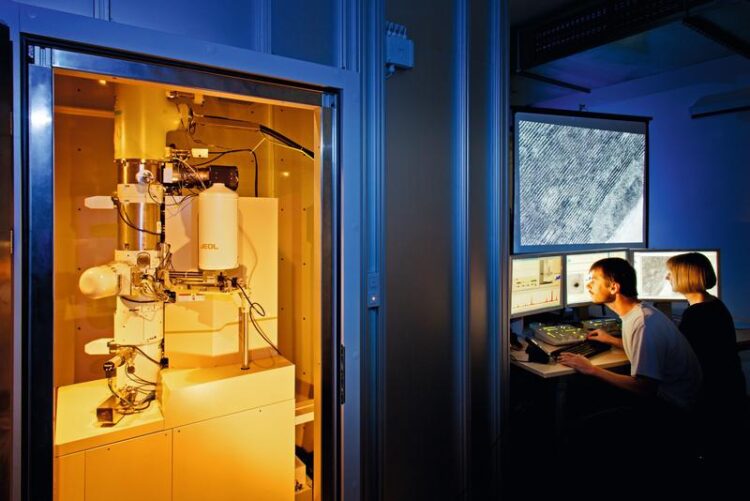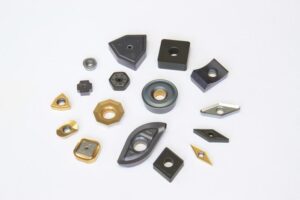Longer drilling, turning, milling

Researchers investigating a sample of the hard coating in the transmission electron microscope.
Photo: TU Bergakademie Freiberg / D. Müller
TU Freiberg analyses the microstructure of hard material layers in drill tips.
Researchers of TU Bergakademie Freiberg cooperate with the Dresden Fraunhofer Institute for Ceramic Technologies and Systems (IKTS) and the Czech branch of the Dormer Pramet Company on the development of novel hard coatings for sustainable use in cutting tools. By working on the nanoscale, they modify the interfaces between individual thin layers in the coatings in order to improve their adhesion. When the drill tips are covered with the innovative coatings, the tool life for drilling, turning or milling can be extended by up to 30 percent.

Photo: TU Bergakademie Freiberg
The examined drill bits consist of stacks of two extremely thin but hard layers that are manufactured in a high-temperature reactor by the industrial partner Dormer Pramet. The top layer consists of aluminum oxide, the underlying layer of titanium carbonitride. When the thin film stacks are used as protective coatings on the inserts in cutting tools, they reduce the wear and enhance the service lives of the insets. Such cutting tools are used in particular for high-speed machining of metals, where high temperatures develop. The main problem of the thin film stacks are the inner interfaces between individual layers. Professor David Rafaja, materials scientist from TU Bergakademie Freiberg, explains: “Due to the different crystal structures of titanium carbonitride and aluminum oxide, the counterpart materials do not fit perfectly onto each other. They do not interlock.”
During the drilling process, cracks appear in the aluminum oxide top layer and this peels off. Without the top layer that prevents the oxidation of the titanium carbonitride, the tool parts corrode and the cutting and drilling inserts must be replaced. “If you want to ensure that the tools can stay longer in operation, you must first understand how the interface between the two layers, each being a few micrometers thick, is built-up and why the individual layers are not ideally joined,” Professor David Rafaja adds.
Interface studies at the nanoscopic level
The team led by Professor David Rafaja examines the formation of the intermediate layer more closely – at the atomic level. At the interface between the two layers, transition phases and nanoscale structures form, which allow the two materials to interlock like in a zipper, but on the atomic level. The researchers can manipulate the formation of these transition phases through chemical reactions: By adjusting the proportions between the starting materials and the pressure and temperature in the reactor, the team achieves a better compatibility of the crystal structures and a better adhesion of the layers at their interface. In addition, using this approach the researchers can tailor the strain in the crystal lattices.
The modified intermediate layers, which are produced under laboratory conditions at the IKTS, serve as a barrier for crack propagation and simultaneously as a diffusion barrier. Dr. Christina Wüstefeld, head of the Thin Film group at the Institute of Materials Science explains: “The intermediate layer is designed to block the separation of the layers. The greatest challenge is to produce an intermediate layer, which is able to compensate the large differences in the crystal structures of titanium carbonitride and aluminum oxide, even if it has a maximum thickness of one micrometer.” For comparison: a human hair is about 50 micrometers thick.
High-resolution microstructure analysis allows new insights into the atomic structure
In order to be able to analyze the interfaces in such details, Dr. Christiane Ullrich uses high-resolution electron microscopy and a complex sample preparation procedure. “First, a lamella having a thickness of less than a hundred nanometers is cut out of the surface of the hard coating using a focused ion beam and then further thinned down using an ion polishing process”, the research fellow explains. The team investigates the ultra-thin samples using a high-resolution analytical transmission electron microscope that combines the imaging at the atomic resolution with local spectroscopic methods.
Cutting tools with a longer service life
In the Czech town of Šumperk, the new hard coatings are being tested for their practical suitability at the Dormer Pramet Company. Dr. Michal Šíma, subproject manager, comments on the possible transfer of the research results to the production: “The first results show how the individual parameters of the deposition process influence the nature of the intermediate layer and how we can tailor the properties of the hard material layers in an industrial scale process.”
The EU network M-era.net
The project “Microstructure Design of Innovative Interfaces of CVD Hard Coatings (MiDiCoat)” having a total volume of one million euros is a part of the M-era.Net network, which is funded by the European Union. Since 2012, M-era.Net supports and coordinates European research and innovation programs – particularly in the field of materials science and technology. The M-era.Net consortium contributes to the ongoing restructuring of the European Research Area (ERA). It promotes scientific excellence and the transfer of the results of basic research into practice as a basis for industrial innovations. M-era.Net endeavors to develop long-term cooperation between research funding organizations in individual regions, in Europe and worldwide.
Wissenschaftliche Ansprechpartner:
Prof. Dr. David Rafaja, Institute of Materials Science, rafaja@ww.tu-freiberg.de, + 49-3731-39 2299
Media Contact
All latest news from the category: Materials Sciences
Materials management deals with the research, development, manufacturing and processing of raw and industrial materials. Key aspects here are biological and medical issues, which play an increasingly important role in this field.
innovations-report offers in-depth articles related to the development and application of materials and the structure and properties of new materials.
Newest articles

Parallel Paths: Understanding Malaria Resistance in Chimpanzees and Humans
The closest relatives of humans adapt genetically to habitats and infections Survival of the Fittest: Genetic Adaptations Uncovered in Chimpanzees Görlitz, 10.01.2025. Chimpanzees have genetic adaptations that help them survive…

You are What You Eat—Stanford Study Links Fiber to Anti-Cancer Gene Modulation
The Fiber Gap: A Growing Concern in American Diets Fiber is well known to be an important part of a healthy diet, yet less than 10% of Americans eat the minimum recommended…

Trust Your Gut—RNA-Protein Discovery for Better Immunity
HIRI researchers uncover control mechanisms of polysaccharide utilization in Bacteroides thetaiotaomicron. Researchers at the Helmholtz Institute for RNA-based Infection Research (HIRI) and the Julius-Maximilians-Universität (JMU) in Würzburg have identified a…



